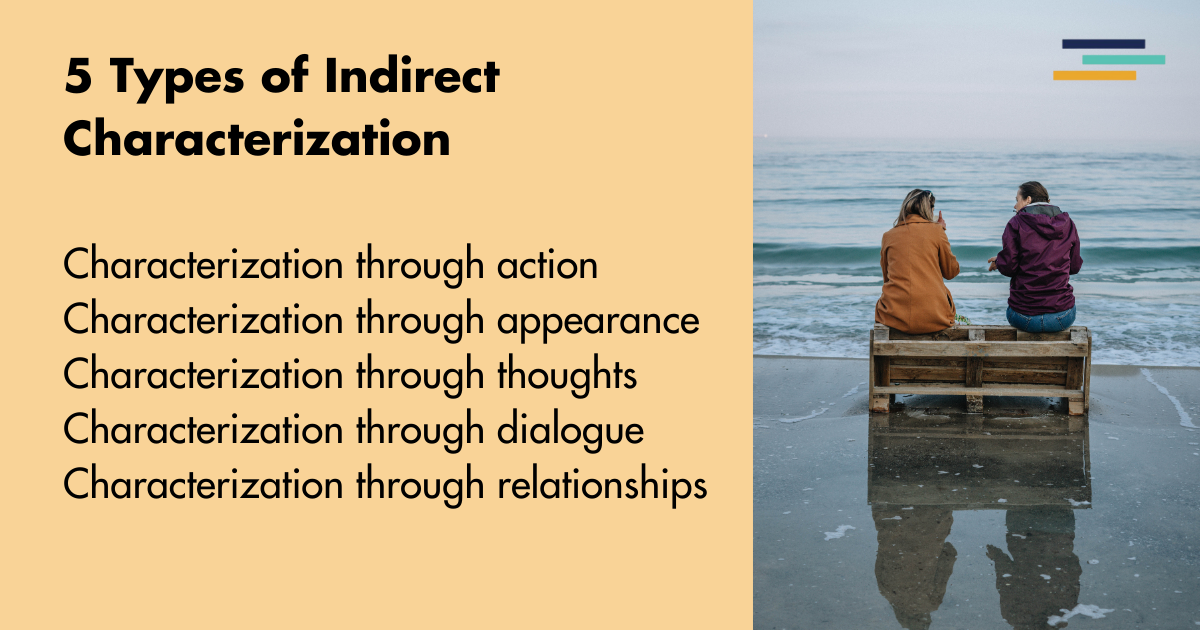
Indirect Characterization is a helpful tool that authors can use to add complexity to their characters. This method of storytelling unveils characters in a literary context that doesn’t explicitly tell the reader what they are like. This can be achieved by the words and actions of the characters or their private thoughts, as well as how the other characters treat them. Alternatively, direct characterization gives those details through overt description.
It is important to develop depth with a character so readers are eager to discover more. Indirect characterization does this by demonstrating qualities as they would be experienced. Picture it like meeting a person in real life. You learn about them gradually, and you make your mind up about them along the way. This way of learning about a character feels much more natural.
While indirect characterization is very helpful to build a fleshed out character, there are downsides if it is overused without direct information. Indirect characterization gives a picture to the reader that lets them decide what to think. The reader has freedom in how they perceive characters, but important details can slip through the cracks.
If crucial details are not prioritized, there is a risk of the reader being misled or confused. Also, descriptions of the character can appear over-saturated with superfluous information. Your approach should form a complex character but not overwhelm the reader with details.
What Is Characterization?
Characterization in literature is how a writer develops and communicates a character. Their thoughts, physical appearance, and habits are how the characters are brought to life.
Indirect and direct characterization are two techniques in which characterization can be broken down. Both types of characterization can be an asset to writers, but here we’re going to focus on indirect characterization.
What is Indirect Characterization?
The tool of character revelation that shows the reader the character’s traits through dialogue, physical appearance, thoughts, and what the character does and how it affects others. This is usually done gradually to present the character in a less direct way.
What Is Direct Characterization?
The tool of character building that spells out the character using implicit detail rather than showing the character to the reader. This can be useful to an author especially when they want to emphasize details that are crucial to the character and the story.

5 Types of Indirect Characterization
Indirect Characterization Through Action
The actions a character makes can clue the reader into their motivations. This can be demonstrated through their mannerisms as well as their physical actions.
If a character is shaking while speaking in front of others, this might tell the reader that they are nervous when talking to people and may lack self confidence.
An example of physical actions being used to express indirect characterization is a character offering their seat to someone on the bus. This could imply that they are polite and take notice of others around them.
You want to ask yourself what the actions say to the reader about the character. Why do they give up their seat on the bus? Is to look good to others or because they are genuinely kind. You can reveal your character’s intentions by showing them in action.
Indirect Characterization Through Appearance
How a character presents themselves can be very telling. The writer’s description shows something about the character.
For instance, describing the character as having “large alluring eyes and shiny black hair” can hint at the character being attractive and healthy. The appearance of the character can also give a hint to their inner psyche.
An example of this would be to describe a character with chewed up nails and wild eyes. These physical signs might suggest severe stress or panic. This type of indirect characterization can also be indicative of occupation, such as if the character is wearing a well made suit or a polo shirt with the company name on it.
With these physical details a reader can begin to build a picture in their mind of who the character is.
Indirect Characterization Through Thoughts
The reader has a front row seat to the usually hidden thought life of someone else. The reader is privy to the character’s fantasies and inner musings that they may not reveal to others. What does the character think about that they don’t tell others? This can unveil secrets and important details about the characters and the story. How do they think of others around them? Do they constantly judge others against themselves, or do they feel invisible to people? This could reveal private feelings of loneliness, arrogance, or fear that are important building blocks to who they are.
Indirect Characterization Through Dialogue
The speech of a character can be another useful type of indirect characterization.
Whether the character speaks softly or loudly, frequently, or not at all can be indicative of a character’s disposition. If a character is shy this is shown in the way they softly talk to others or perhaps stutter over their words. A nervous disposition and fear of other people could be behind this.
The actual content of the character’s dialogue is another telling way to illustrate their intent and personality. Do they use eloquent language when speaking to others? This could infer that they are well educated or that they want to show they are smarter than everyone else. Asking why they use the words that they do could be as important as what they say.
Indirect Characterization Through Relationships
Lastly, a character’s effect on others can be a source of indirect characterization for the reader. This type of indirect characterization can tie together dialogue as well as action.
If you have a character that is initially warmly received by peers, only for them to begin whispering once they turn their back, you immediately get a sense of the dynamic without it being explicitly stated. This could reveal that they don’t respect the other character enough to pretend to like them when they’re around. The reader can ascertain what kind of person they are by how other characters react to them whether they are in a scene with them or not.

Indirect Characterization Examples
Now that you have been introduced to the 5 types of indirect characterization, some examples from a famous work of fiction will help to drive the concept home. The beloved classic Pride and Prejudice by Jane Austin offers many examples of Indirect characterization in literature.
Speech in Pride and Prejudice
Elizabeth meeting Darcy for the first time at the Meryton ball is an example of indirect characterization through speech. When Mr. Bingly tells Mr Darcy he should dance, he responds with:
“I certainly shall not. You know how I detest it, Unless I am particularly acquainted with my partner. At such an assembly as this it would be insupportable.”
Mr. Darcy reveals that he believes himself above the present company and that he doesn’t like to dance with strangers. As this is the first time his character is shown, this line is very telling to the reader about what he thinks of himself and others.
Action in Pride and Prejudice
Another event from the scene at the Meryton ball also presents an example of indirect characterization through action. Unlike Mr. Darcy, Mr. Bingly is shown to be likable because of what he does as shown in this phrase:
“Mr. Bingly had soon made himself acquainted with all the principal people in the room, he was lively and unreserved, danced every dance, was angry that the ball closed early, and talked of giving one himself at Netherfield. Such amiable qualities must speak for themselves.”
By introducing himself to people, dancing with different partners, and being friendly, he reveals his outgoing disposition to the reader.
Appearance in Pride and Prejudice
An example of indirect characterization through appearance is when Elizabeth makes the trek to Bingly’s estate on foot to visit her sick sister. Having walked through mud, the state of her clothing is very shocking to Miss Bingley, and she remarks back to her sister:
“… I hope you saw her petticoat, six inches deep in mud, I am absolutely certain; and the gown which had been let down to hide it not doing its office.”
Miss Bingley is disgusted that Elizabeth would appear this way. This line reveals how much Miss Bingley values presentation, but more importantly it shows the protagonist’s lack of concern for how she might appear to others. She is more determined to see her sister than to impress anyone with her clothes.
Thoughts in Pride and Prejudice
A character’s personality can also be displayed in their thoughts. Mr. Bennet in Pride and Prejudice reveals his inner musings of Mr. Collins:
“Mr. Bennet’s expectations were fully answered. His cousin was as absurd as he had hoped, and he listened to him with the keenest enjoyment, maintaining at the same time the most resolute composure of countenance, and, except in an occasional glance at Elizabeth, requiring no partner in his pleasure.”
This example shows Mr. Bennet as having a humorous personality and thinks of some of the other characters as a source of amusement.
The Character’s Effect in Pride and Prejudice
Lastly, the effect a character has on others is seen in this line where the likability of Wickam is displayed:
“Mr. Wickham was the happy man towards whom almost every female eye was turned, and Elizabeth was the happy woman by whom he finally seated himself;…”
The attention that Wickham receives shows that not only is he attractive, but he is pleased to be the center of attention.
How to Use Indirect Characterization
In addition to utilizing the five types of indirect characterization, there are some tips you’ll want to keep in mind. Successful character building blends both direct and indirect characterization. Consider using direct characterization to make important details clear to the reader, then indirect to expand on them as you move on in the story.
The use of a character’s setting can be a great way to incorporate indirect characterization. For instance if the character’s home is predominantly decorated in pink and porcelain china, writers can show that the character likes a traditional style of decor and favors a specific shade over others.
If a writer wants to indirectly emphasize a character trait, they can reiterate a character trait that they want to stick out. Perhaps the writer wants to convey that a character is afraid of small spaces. Instead of the character spelling this out, this could be shown through repetition. The character could have trouble breathing when entering an elevator then shown as anxious when forced to enter a small hallway. This is a great way to deliver important details that stick out in the memory of a reader.
Indirect characterization is a great storytelling tool that can actualize characters that feel real. Writers can employ the five types of indirect characterization to portray characters as complex and three dimensional. Enjoy experimenting with this helpful tool to bring your characters to life.


